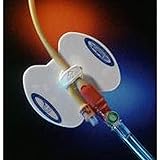The Foley catheter is a crucial medical device used in various healthcare settings for urinary drainage. To secure a Foley catheter in place, the Foley Stat Lock is employed. While this device is designed to maintain catheter position and reduce discomfort, users often encounter challenges. This article delves into common issues faced with Foley Stat Locks and offers practical solutions to enhance patient care and safety.
Understanding Foley Stat Lock

Before addressing the challenges, it is essential to understand what a Foley Stat Lock is. A Foley Stat Lock is a device that secures a Foley catheter to the patient’s leg, minimizing movement and preventing accidental dislodgement. The Stat Lock typically consists of adhesive pads and a locking mechanism that holds the catheter securely in place.
Common Challenges with Foley Stat Lock

Despite its utility, several challenges can arise when using a Foley Stat Lock. Here are some of the most prevalent issues:
- Adhesive Failure: The adhesive may not stick properly to the skin, leading to premature detachment.
- Skin Irritation: Prolonged use can cause skin irritation or allergic reactions at the site of application.
- Improper Placement: If not positioned correctly, the Stat Lock may not effectively secure the catheter, increasing the risk of displacement.
- Patient Discomfort: Some patients may find the Stat Lock uncomfortable, leading to increased anxiety or agitation.
- Limited Mobility: While the Stat Lock aims to secure the catheter, it may inadvertently restrict patient movement.
Strategies to Overcome Challenges
Addressing these challenges requires a combination of best practices, staff education, and patient engagement. Below are strategies to overcome common issues associated with the Foley Stat Lock:
1. Ensuring Proper Adhesive Functionality

Adhesive failure is a common challenge. To prevent this:
- Skin Preparation: Clean the skin thoroughly with an appropriate antiseptic and allow it to dry completely before application.
- Use of Barrier Creams: Consider applying a barrier cream on the skin to protect it and enhance adhesive quality.
- Regular Inspection: Monitor the Stat Lock regularly for signs of detachment and replace it as needed.
2. Minimizing Skin Irritation
Skin irritation can occur due to prolonged use or allergic reactions. To mitigate this:
- Choose Hypoallergenic Options: Opt for hypoallergenic adhesive products for patients with sensitive skin.
- Regular Skin Assessment: Conduct daily skin assessments to identify irritation early and adjust care plans accordingly.
- Rotate Application Sites: If feasible, consider rotating the application site to minimize continuous pressure on a single area.
3. Correcting Placement Issues

Improper placement can lead to ineffective catheter security. To ensure correct placement:
- Training and Education: Provide thorough training for healthcare staff on the correct application techniques for the Foley Stat Lock.
- Use of Visual Aids: Employ diagrams or instructional videos to guide staff during the application process.
- Involve Patients: Educate patients about the purpose of the Stat Lock and involve them in the placement process to ensure comfort.
4. Addressing Patient Discomfort

Patient discomfort can lead to agitation and non-compliance. To enhance comfort:
- Regular Communication: Maintain open lines of communication with patients, asking about their comfort levels and addressing concerns promptly.
- Adjust Fit: Ensure that the Stat Lock is not too tight, which can cause discomfort. Adjustments should be made based on patient feedback.
- Patient Education: Educate patients about the purpose of the Foley catheter and Stat Lock, helping to alleviate anxiety.
5. Enhancing Patient Mobility
While the goal is to secure the catheter, mobility should not be compromised. To facilitate movement:
- Proper Catheter Length: Ensure that the catheter length is appropriate to allow for movement without tension on the Stat Lock.
- Adjustable Straps: Use Stat Locks with adjustable straps that can accommodate patient movements while maintaining security.
- Encourage Movement: Encourage patients to engage in gentle mobility exercises as permitted by their condition to minimize stiffness and discomfort.
Case Studies and Examples

Real-world examples can help illustrate the effectiveness of these strategies. In a study conducted at the XYZ Hospital, nurses reported a 30% reduction in adhesive failure by implementing proper skin preparation protocols and educating patients on the Stat Lock’s purpose. Another case involved a geriatric unit where hypoallergenic Stat Locks were introduced, resulting in a significant decrease in skin irritation complaints among residents.
Furthermore, a pilot program at ABC Medical Center focused on staff training and education led to a 25% decrease in improper placement incidents over three months. This case highlights the importance of ongoing training and the positive impact it can have on patient outcomes.
While the Foley Stat Lock is an invaluable tool in catheter management, challenges such as adhesive failure, skin irritation, improper placement, patient discomfort, and mobility restrictions can hinder its effectiveness. By implementing proper skin preparation, choosing hypoallergenic options, ensuring correct placement, addressing patient comfort, and facilitating mobility, healthcare providers can significantly improve patient outcomes.
Ongoing education and communication are vital in overcoming these challenges. By adopting a proactive approach, healthcare professionals can enhance patient satisfaction and safety, ultimately leading to better healthcare experiences. The key takeaway is that with the right strategies in place, the challenges associated with Foley Stat Locks can be effectively managed, ensuring a smoother experience for both patients and healthcare providers.